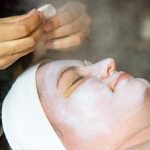The Basics
Microdermabrasion is a general term for the application of tiny rough grains to buff away the surface layer of skin. Many different products and treatments use this method, including medical procedures, salon treatments, and creams and scrubs that you apply yourself at home. It’s usually done to the face, chest, neck, arms, or hands. Before we can understand how microdermabrasion does what it does, it’s important to understand how the skin works.
Your skin is made up of two main layers, the epidermis, and the dermis. The epidermis is the layer closest to the outside world. It’s a set of dead skin cells on top of another layer of cells that are in the process of maturing. The topmost layer is called the stratum corneum. The stratum corneum mostly acts as a barrier between the outside world and the lower skin layers. It keeps all but the smallest molecules from getting through.
When you put lotions or creams on your skin, some of the moisture passes through the stratum corneum, but not all of it. This layer is home to many minor skin imperfections like fine wrinkle lines and blemishes.
All of the action in microdermabrasion takes place at the level of the stratum corneum. Since it only really targets the epidermis (and not the dermis), it is more accurate to call it micro-epi-dermabrasion. Affecting deeper layers of skin would be painful and harmful, and it would risk permanently embedding the tiny grains into the skin.
Microdermabrasion Effects
Whether done with a product at home or in a professional setting with a specialized tool, the principle of microdermabrasion is the same. The idea is that if you remove or break up the stratum corneum, the body interprets that as a mild injury and rushes to replace the lost skin cells with new and healthy ones. In the first hour after treatment, this causes mild edema (swelling) and erythema (redness). Depending on the individual, these side effects can last anywhere from an hour to two days.
This process has a few beneficial effects. With the stratum corneum gone, the skin’s surface is improved. The healing process brings with it newer skin cells that look and feel smoother. Some of the skin’s visible imperfections, like sun damage, blemishes, and fine lines, are removed. Also, without the stratum corneum acting as a barrier, medicinal creams and lotions are more effective because more of their active ingredients and moisture can find their way down to the lower layers of skin. As microdermabrasion temporarily removes some moisture from the skin, it is always followed by the application of moisturizing creams.
Early studies suggest that repeated microdermabrasion treatment at regular intervals may influence the way the lower layers of skin grow, as well, removing deeper blemishes over time. Some evidence seems to indicate that the rapid loss of skin moisture may be what triggers the lower skin layers to work overtime in speeding healthy cells up to the surface.


